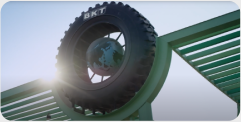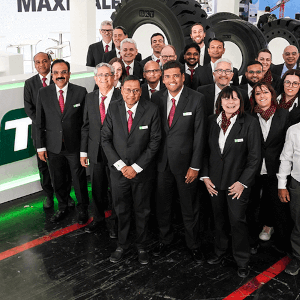Material handling vehicles are specialized machines designed to transport, store, control, and protect materials and products within warehouses, factories, and other industrial environments. These vehicles play a critical role in streamlining processes, increasing productivity, and ensuring the safe handling of materials. Common types of material handling vehicles include forklifts, pallet trucks, order pickers, and reach trucks, each with specific functions and capabilities.
The Right At-tire
Material handling vehicles play a crucial role in ensuring smooth operations and maintaining efficiency within many business supply chains, and as with any industrial setting, tires can have a significant impact on overall performance, safety, and the cost of operations. Today, we explore the key factors to consider when selecting industrial tires for your material handling equipment, and highlight the high-quality options offered by BKT Tires.
Get to Grips with Material Handling Tires
1. Understand the Types of Tires for Material Handling Equipment
When considering the right tires for your vehicle, a good place to start is looking at the different types of tires available for material handling equipment. There are three main types of tires to be aware of, each with a unique set of features and benefits that qualify them for different applications. Understanding these types will help you make an informed decision.
-
Solid Tires: Solid tires are made from solid rubber. These tires are puncture-resistant, making them ideal for harsh environments with sharp objects, debris, or rough surfaces. They offer excellent stability and durability, ensuring a long lifespan with minimal maintenance.
-
Bias Tires: Bias tires, also known as cross-ply tires, are constructed using layers of nylon or polyester cords, known as plies, arranged in a diagonal pattern from bead to bead. The plies overlap each other, creating a thick, sturdy sidewall that provides excellent resistance to impacts and punctures. Bias tires are typically more affordable than radial tires, but they may have a shorter lifespan and lower fuel efficiency due to increased rolling resistance. On the upside, they can offer greater stability and comfort to operators when used on rough surfaces, and typically withstand higher loads than radial tires.
-
Radial Tires: Radial tires are constructed using steel belts or fabric plies that run perpendicular to the tire's direction of travel, creating a more flexible sidewall. The tread and sidewall function independently, allowing for better road contact and more even tread wear. Radial tires offer improved fuel efficiency, longer lifespan, and a smoother ride compared to bias tires, especially when operating vehicles at higher speeds. However, they are generally more expensive and may be less resistant to sidewall damage.
2. Evaluate Your Work Environment
The unique characteristics of your work environment play a significant role in determining the type of tires you should choose for your material handling equipment. It's essential to take the following factors into account while making your decision:
-
Surface Conditions: Assess the surface conditions in which your equipment will be operating. Solid tires are suitable for smooth, flat surfaces, while radial tires are better suited for uneven terrain or outdoor applications due to their enhanced traction and stability.
-
Exposure to Chemicals: If your material handling equipment will be exposed to chemicals, oil, or grease, it's crucial to choose tires that can withstand these substances. Both solid and bias tires, as well as some radial tires, are made from specialized compounds that resist chemical damage, ensuring a longer lifespan.
-
Temperature: Extreme temperatures can impact the performance of your tires. Whether your equipment operates in hot or cold environments, opt for tire types like solid, bias, or radial tires, specifically designed to withstand these conditions without compromising performance or safety.
3. Load Capacity and Tire Size
The load capacity and tire size are crucial factors to consider when selecting industrial tires. Overloading your tires can lead to premature wear and potential safety hazards. Always check the manufacturer's recommendations for load capacity and ensure that the tires you choose can support the weight of your equipment and the materials you handle.
4. Opt for High-Quality Tires from Reputable Manufacturers
Investing in high-quality industrial tires from reputable manufacturers is a wise decision, as they offer enhanced performance, safety, and durability. At BKT, our tires are rigorously tested to ensure optimum performance across a range of conditions, and importantly, to enhance safety and comfort for industrial workers.
Here, we share some of our most popular tires for material handling applications:
a. LIFTMAX LM 81: The LIFTMAX LM 81 has been thoughtfully developed and tailored specifically for heavy-duty forklifts and terminal tractors. It features a bold and durable tread design, teamed with a one-of-a-kind antistatic tread compound. This delivers impressive resistance to wear and a lengthy lifespan, whilst also dissipating static charge from the vehicle.
The LIFTMAX LM 81 sets itself apart with a rock-solid all-steel casing and a reinforced sidewall, joining forces to deliver top-notch stability and handling when lifting, as well as exceptional traction. Meanwhile, the radial casing is constructed to smooth out surface imperfections, which results in enhanced riding comfort and increased operator assurance. Let the good times roll with the LIFTMAX LM 81!
b. MAGLIFT (RIM GUARD): Expertly designed and tailored specifically for heavy-duty forklifts operating in industrial and logistic facilities, the MAGLIFT (RIM GUARD)’s bold and sturdy tread pattern delivers exceptional forward and lateral traction, along with excellent steering control. The solid construction of the MAGLIFT (RIM GUARD) also boasts a high load capacity, whilst offering impressive comfort for its operator. The tire also exhibits excellent resistance to cuts and chips, resulting in an extended tire life (and thus lower operating expenses!)
c. SNOW GRIP: Operating in colder climes? S-no-w problem! Specially engineered for forklifts braving low-temperature environments, our SNOW GRIP tire has a one-of-a-kind tread design that boasts numerous ‘gripping’ edges that cling to fresh or compact snow like there's no tomorrow. Say hello to exceptional cornering and braking performance on icy and snowy surfaces, making your forklift feel like it's dancing on ice.
But that's not all! The SNOW GRIP's dual bead construction, robust casing, and reinforced sidewall come together to provide higher load capacity, superb stability, and handling in lift mode – not to mention a long-lasting tire life. With SNOW GRIP, your forklift will be the coolest thing on the cold, slippery ground!
For more information visit our website, or contact us for specialist advice and recommendations.






.jpg)